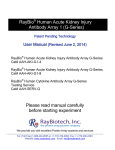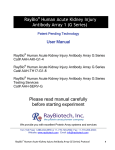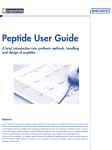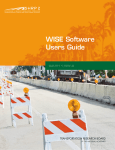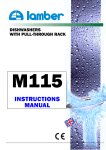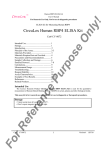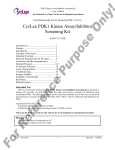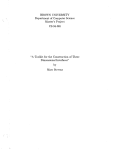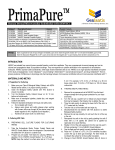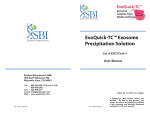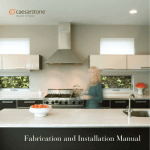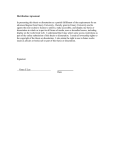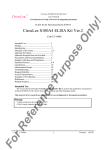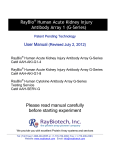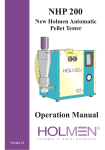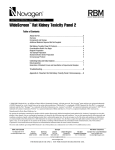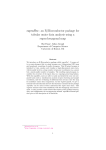Download CY-8053 Rat NGAL/Lipocalin
Transcript
Rat NGAL/Lipocalin-2 ELISA Kit User’s Manual For Research Use Only, Not for use in diagnostic procedures ELISA Kit for Measuring Rat NGAL/Lipocalin-2 On ly! CircuLex TM CircuLex Rat NGAL/Lipocalin-2 ELISA Kit Pu rp Intended Use................................................ 1 Storage......................................................... 1 Introduction.................................................. 2 Principle of the Assay.................................. 3 Materials Provided....................................... 4 Materials Required but not Provided........... 5 Precautions and Recommendations.............. 6 Sample Collection and Storage.................... 7 Detailed Protocol........................................... 8-10 Calculations..................................…............. 10 Measurement Range.................................... 11 Troubleshooting........................................... 11 Reagent Stability.......................................... 11 Assay Characteristics................................... 12-13 Example of Test Results............................... 14 References.................................................... 14-15 Related Products........................................... 16 os e Cat# CY-8053 ce Intended Use The CycLex Research Product CircuLex Rat NGAL/Lipocalin-2 ELISA Kit is used for the quantitative measurement of rat NGAL/Lipocalin-2 in serum, plasma, urine, tissue culture medium and other biological media. en This assay kit is for research use only and not for use in diagnostic or therapeutic procedures. Storage rR ef er • Upon receipt store all components at 4°C. • Don’t expose reagents to excessive light. Fo Cat#: CY-8053 1 Version#: 140318 Rat NGAL/Lipocalin-2 ELISA Kit User’s Manual For Research Use Only, Not for use in diagnostic procedures On ly! CircuLex TM Introduction rR ef er en ce Pu rp os e Human neutrophil gelatinase-associated lipocalin (NGAL), also called human lipocalin-2, was originally identified as an associated protein to 92-kDa human neutrophil type IV collagenase, also called gelatinase B or matrix metalloproteinase-9 (MMP-9) (1). The rat ortholog, neu-related lipocalin (NRL) or α2-microglobulin-related protein, was identified as a protein highly overexpressed in mammary cancers. The murine ortholog, called 24p3, 24 kDa superinducible protein (Sip24), or uterocalin, was identified as a protein induced in response to various proliferative signals and is highly expressed in uterine luminal fluids and epithelial cells. Recently, 24p3 has also been implicated in processes as diverse as apoptosis (2) and kidney cell differentiation (3). NGAL, like most lipocalins, is thought to modulate cellular processes by binding to ligand(s) and interacting with specific cell-surface receptors. Evidence for such a mammalian receptor for NGAL has recently been reported (2). One early hypothesis proposed that NGAL has immunomodulatory activity by binding and clearing lipophilic inflammatory mediators (4), such as the neutrophil tripeptide chemoattractant N-formyl-Met-Leu-Phe (5, 6). NGAL is released from the secondary granules of activated neutrophils (1) and plasma levels rise in inflammatory or infective conditions, especially in bacterial infections (7). Thus the level of NGAL in plasma or serum has been proposed as a marker of infection. However, as levels of NGAL may also be raised in neoplastic conditions and renal disorders independently of any infective process, this proposed application should be treated with caution. An early and dramatic upregulation was later observed in rat proximal tubule cells after ischemia-reperfusion injury (8), and raised plasma levels of NGAL were found to be strongly correlated with decreased renal function in patients with renal damage due to systemic vasculitis (9). The results for renal ischemia-reperfusion injury were subsequently confirmed and extended to nephrotoxic agents (10-12). It has been suggested that urinary NGAL levels may serve as an early marker for ischemic renal injury in children after cardiopulmonary bypass (13). Fo Cat#: CY-8053 2 Version#: 140318 Rat NGAL/Lipocalin-2 ELISA Kit User’s Manual For Research Use Only, Not for use in diagnostic procedures On ly! CircuLex TM Principle of the Assay os e The CycLex Research Product CircuLex Rat NGAL/Lippocalin-2 ELISA Kit employs the quantitative sandwich enzyme immunoassay technique. An antibody specific for rat NGAL has been pre-coated onto a microplate. Standards and samples are pipetted into the wells and the immobilized antibody binds any rat NGAL present. After washing away any unbound substances, a biotinylated antibody specific for rat NGAL is added to the wells, followed by binding with horseradish peroxidase (HRP) conjugated Streptavidin, which then catalyzes the conversion of the chromogenic substrate tetra-methylbenzidine (TMB) from a colorless solution to a blue solution (or yellow after the addition of stopping reagent). The reaction is stopped by addition of acidic solution and absorbance of the resulting yellow product is measured at 450 nm. The absorbance is proportional to the concentration of rat NGAL. A standard curve is constructed by plotting absorbance values versus rat NGAL concentrations of calibrators, and concentrations of unknown samples are determined using this standard curve. The CircuLex Rat NGAL/Lipocalin-2 ELISA Kit is designed to measure the concentration of rat NGAL/Lipocalin-2 from serum/plasma, urine, cultured macrophages, or conditioned medium. Pu rp Summary of Procedure Add 100 µL of diluted sample to the wells Incubate for 1 hour at room temp. Wash the wells Add 100 µL of biotinylated anti-rat NGAL antibody Incubate for 1hour at room temp. ce Wash the wells Add 100 µL of HRP conjugated Streptavidin Incubate for 20 minutes at room temp. en Wash the wells Add 100 µL of Substrate Reagent er Add 100 µL of Stop Solution rR ef Measure absorbance at 450 nm Fo Cat#: CY-8053 3 Version#: 140318 Rat NGAL/Lipocalin-2 ELISA Kit User’s Manual For Research Use Only, Not for use in diagnostic procedures On ly! CircuLex TM Materials Provided All samples and standards should be assayed in duplicate. The following components are supplied and are sufficient for the one 96-well microplate kit. Microplate: One microplate supplied ready to use, with 96 wells (12 strips of 8-wells) in a foil, zip-lock bag with a desiccant pack. Wells are coated with anti-rat NGAL antibody as a capture antibody. 10X Wash Buffer: One bottle containing 100 mL of 10X buffer containing 2%Tween®-20 os e Dilution Buffer: One bottle containing 50 mL of 1X buffer; use for sample dilution. Ready to use. Rat NGAL Standard: One vials containing 4 ng each of lyophilized recombinant rat NGAL Biotinylated Detection Antibody: One bottle containing 12 mL of biotinylated anti-rat NGAL antibody. Ready to use. Pu rp HRP conjugated Streptavidin: One bottle containing 12 mL of HRP (horseradish peroxidase) conjugated streptavidin. Ready to use. Substrate Reagent: One bottle containing 20 mL of the chromogenic substrate, tetra-methylbenzidine (TMB). Ready to use. rR ef er en ce Stop Solution: One bottle containing 20 mL of 1 N H2SO4. Ready to use. Fo Cat#: CY-8053 4 Version#: 140318 Rat NGAL/Lipocalin-2 ELISA Kit User’s Manual For Research Use Only, Not for use in diagnostic procedures On ly! CircuLex TM Materials Required but not Provided • Pipettors: 2-20 µL, 20-200 µL and 200-1000 µL precision pipettors with disposable tips. • Precision repeating pipettor • Orbital microplate shaker • Microcentrifuge and tubes for sample preparation. os e • Vortex mixer • Microplate washer: optional (Manual washing is possible but not preferable) • Plate reader capable of measuring absorbance in 96-well plates at dual wavelengths of 450 nm/540 nm. Dual wavelengths of 450/550 or 450/595 nm can also be used. The plate can also be read at a single wavelength of 450 nm, which will give a somewhat higher reading. • 500 or 1000 mL graduated cylinder • Reagent reservoirs • Deionized water of the highest quality rR ef er en ce • Disposable paper towels Pu rp • Software package facilitating data generation and analysis :optional Fo Cat#: CY-8053 5 Version#: 140318 Rat NGAL/Lipocalin-2 ELISA Kit User’s Manual For Research Use Only, Not for use in diagnostic procedures Precautions and Recommendations • Allow all the components to come to room temperature before use. On ly! CircuLex TM • All microplate strips that are not immediately required should be returned to the zip-lock pouch, which must be carefully resealed to avoid moisture absorption. • Do not use kit components beyond the indicated kit expiration date. os e • Use only the microtiter wells provided with the kit. • Rinse all detergent residue from glassware. • Use deionized water of the highest quality. • Do not mix reagents from different kits. Pu rp • The buffers and reagents in this kit may contain preservatives or other chemicals. Care should be taken to avoid direct contact with these reagents. • Do not mouth pipette or ingest any of the reagents. • Do not smoke, eat, or drink when performing the assay or in areas where samples or reagents are handled. • Dispose of tetra-methylbenzidine (TMB) containing solutions in compliance with local regulations. • Avoid contact with Substrate Solution which contains hydrogen peroxide. ce • Avoid contact with Stop Solution which contains Sulfuric Acid. en • Wear gloves and eye protection when handling immunodiagnostic materials and samples of human origin, and these reagents. In case of contact with the Stop Solution and the Substrate Solution, wash skin thoroughly with water and seek medical attention, when necessary. • Biological samples may be contaminated with infectious agents. Do not ingest, expose to open wounds or breathe aerosols. Wear protective gloves and dispose of biological samples properly. rR ef er • CAUTION: Sulfuric Acid is a strong acid. Wear disposable gloves and eye protection when handling Stop Solution. Fo Cat#: CY-8053 6 Version#: 140318 Rat NGAL/Lipocalin-2 ELISA Kit User’s Manual For Research Use Only, Not for use in diagnostic procedures On ly! CircuLex TM Sample Collection and Storage Serum: Use a serum separator tube and allow samples to clot for 60 ± 30 minutes. Centrifuge the samples at 4°C for 10 minutes at 1,000 x g. Remove serum and assay immediately or store samples on ice for up to 6 hours before assaying. Aliquots of serum may also be stored at below -70°C for extended periods of time. Avoid repeated freeze-thaw cycles. os e Plasma: Collect plasma using EDTA-Na2 or heparin as the anticoagulant. If possible, collect the plasma into a mixture of EDTA-Na2 and Futhan5 to stabilize the sample against spontaneous in vitro complement activation. Immediately centrifuge samples at 4°C for 15 minutes at 1,000 x g. Assay immediately or store samples on ice for up to 6 hours before assaying. Aliquots of plasma may also be stored at below -70°C for extended periods of time. Avoid repeated freeze-thaw cycles. Note: Citrate plasma has not been validated for use in this assay. Pu rp Urine: Immediately centrifuge samples at 4°C for 15 minutes at 15,000 x g. Assay immediately the supernatant or store on ice for up to 24 hours before assaying. Aliquots of urine may also be stored at below -70°C for extended periods of time. Avoid repeated freeze-thaw cycles. rR ef er en ce Other biological samples: Remove any particulates by centrifugation and assay immediately or aliquot and store samples at below -70°C. Avoid repeated freeze-thaw cycles. Fo Cat#: CY-8053 7 Version#: 140318 Rat NGAL/Lipocalin-2 ELISA Kit User’s Manual For Research Use Only, Not for use in diagnostic procedures On ly! CircuLex TM Detailed Protocol The CycLex Research Product CircuLex Rat NGAL/Lipocalin-2 ELISA Kit is provided with removable strips of wells so the assay can be carried out on separate occasions using only the number of strips required for the particular determination. Since experimental conditions may vary, an aliquot of the rat NGAL Standard within the kit, should be included in each assay as a calibrator. Disposable pipette tips and reagent troughs should be used for all liquid transfers to avoid cross-contamination of reagents or samples. Preparation of Working Solutions os e All reagents need to be brought to room temperature prior to the assay. Assay reagents are supplied ready-to-use, with the exception of 10X Wash Buffer and Rat NGAL Standard. 1. Prepare a working solution of Wash Buffer by adding 100 mL of the 10X Wash Buffer to 900 mL of deionized (distilled) water (ddH2O). Mix well. Store at 4°C for two weeks or -20°C for long-term storage. Pu rp 2. Reconstitute Rat NGAL Standard with 1.0 mL of ddH2O. The concentration of the rat NGAL in vial should be 4 ng/mL, which is referred as a Master Standard of rat NGAL. Prepare Standard Solutions as follows: Use the Master Standard to produce a dilution series (below). Mix each tube thoroughly before the next transfer. The 1,000 pg/mL standard (Std.1) serves as the highest standard. The Dilution Buffer serves as the zero standard (Blank). Volume of Standard 150 µL of Master Standard 300 µL of Std. 1 (1,000 pg/mL) 300 µL of Std. 2 (500 pg/mL) 300 µL of Std. 3 (250 pg/mL) 300 µL of Std. 4 (125 pg/mL) 300 µL of Std. 5 (62.5 pg/mL) 300 µL of Std. 6 (31.3 pg/mL) en ce Std.1 Std.2 Std.3 Std.4 Std.5 Std.6 Std.7 Blank - Dilution Buffer 450 µL 300 µL 300 µL 300 µL 300 µL 300 µL 300 µL 300 µL Concentration 1,000 pg/mL 500 pg/mL 250 pg/mL 125 pg/mL 62.5 pg/mL 31.3 pg/mL 15.6 pg/mL 0 pg/mL rR ef er Note: Do not use a Repeating pipette. Change tips for every dilution. Wet tip with Dilution Buffer before dispensing. Unused portions of Master Standard should be aliquoted and stored at below -70°C immediately. Avoid multiple freeze and thaw cycles. Fo Cat#: CY-8053 8 Version#: 140318 Rat NGAL/Lipocalin-2 ELISA Kit User’s Manual For Research Use Only, Not for use in diagnostic procedures On ly! CircuLex TM Sample Preparation • Serum and plasma samples usually require a 500-fold or 1,000-fold dilution with Dilution Buffer. • Urine samples usually require a 100-fold to 5,000-fold dilution with Dilution Buffer. Note-1: Please predict the concentration before carrying out assay. If values for these are not within the range of the standard curve, users must determine the optimal sample dilutions for their particular experiments. os e Note-2: Dilutions lower than 10-fold should not be used. Assay Procedure Pu rp 1. Prepare the assay protocol, assigning the appropriate wells for setting up Standard Solutions, diluted patient specimens and any internal laboratory controls in duplicate. Remove the appropriate number of microtiter wells from the foil pouch and place them into the well holder. Return any unused wells to the foil pouch, refold, seal with tape and store at 4°C. 2. Dilute samples with Dilution Buffer. (See “Sample Preparation” above.) 3. Pipette 100 µL of Standard Solutions (Std1-Std7, Blank) and diluted samples in duplicates, into the appropriate wells. 4. Incubate the plate at room temperature (ca.25°C) for 1 hour, shaking at ca. 300 rpm on an orbital microplate shaker. ce 5. Wash 4-times by filling each well with Wash Buffer (350 µL) using a squirt bottle, multi-channel pipette, manifold dispenser or microplate washer. 6. Add 100 µL of Biotinylated Detection Antibody into each well. en 7. Incubate the plate at room temperature (ca.25°C) for 1 hour, shaking at ca. 300 rpm on an orbital microplate shaker. 8. Wash 4-times by filling each well with Wash Buffer (350 µL) using a squirt bottle, multi-channel pipette, manifold dispenser or microplate washer. er 9. Add 100 µL of HRP conjugated Streptavidin into each well. 10. Incubate the plate at room temperature (ca.25°C) for 20 minutes, shaking at ca. 300 rpm on an orbital microplate shaker. ef 11. Wash 4-times by filling each well with Wash Buffer (350 µL) using a squirt bottle, multi-channel pipette, manifold dispenser or microplate washer. rR 12. Add 100 µL of Substrate Reagent. Avoid exposing the microtiter plate to direct sunlight. Covering the plate with e.g. aluminum foil is recommended. Return Substrate Reagent to 4°C immediately after the necessary volume is removed Fo Cat#: CY-8053 9 Version#: 140318 Rat NGAL/Lipocalin-2 ELISA Kit User’s Manual For Research Use Only, Not for use in diagnostic procedures On ly! CircuLex TM 13. Incubate the plate at room temperature (ca. 25°C) for 10-20 minutes, shaking at ca. 300 rpm on an orbital microplate shaker. The incubation time may be extended up to 30 minutes if the reaction temperature is below than 20°C. 14. Add 100 µL of Stop Solution to each well in the same order as the previously added Substrate Reagent. os e 15. Measure absorbance in each well using a spectrophotometric microplate reader at dual wavelengths of 450/540 nm. Dual wavelengths of 450/550 or 450/595 nm can also be used. Read the microplate at 450 nm if only a single wavelength can be used. Wells must be read within 30 minutes of adding the Stop Solution. Pu rp Note-1: Complete removal of liquid at each step is essential to good performance. After the last wash, remove any remaining Wash Buffer by aspirating or decanting. Invert the plate and blot it against clean paper towels. Note-2: Reliable standard curves are obtained when either O.D. values do not exceed 0.2 units for the blank (zero concentration), or 2.5 units for the highest standard concentration. The plate should be monitored at 5-minute intervals for approximately 30 minutes. Note-3: If the microplate reader is not capable of reading absorbance greater than the absorbance of the highest standard, perform a second reading at 405 nm. A new standard curve, constructed using the values measured at 405 nm, is used to determine rat NGAL concentration of off-scale samples. The readings at 405 nm should not replace the on-scale readings at 450 nm. Calculations ce Average the duplicate readings for each standard, control, and sample and subtract the average zero standard optical density. Plot the optical density for the standards versus the concentration of the standards and draw the best curve. To determine the rat NGAL concentration of each sample, first find the absorbance value on the y-axis and extend a horizontal line to the standard curve. At the point of intersection, extend a vertical line to the x-axis and read the corresponding rat NGAL concentration. If the samples have been diluted, the concentration read from the standard curve must be multiplied by the dilution factor. en 1. The dose-response curve of this assay fits best to a sigmoidal 4-parameter logistic equation. The results of unknown samples can be calculated with any computer program having a 4-parameter logistic function. It is important to make an appropriate mathematical adjustment to accommodate for the dilution factor. er 2. Most microtiter plate readers perform automatic calculations of analyte concentration. The calibration curve is constructed by plotting the absorbance (Y) of calibrators versus log of the known concentration (X) of calibrators, using the four-parameter function. Alternatively, the logit log function can be used to linearize the calibration curve (i.e. logit of absorbance (Y) is plotted versus log of the known concentration (X) of calibrators). rR ef 3. Dilution factors need to be taken into consideration in calculating the rat NGAL concentration. Fo Cat#: CY-8053 10 Version#: 140318 Rat NGAL/Lipocalin-2 ELISA Kit User’s Manual For Research Use Only, Not for use in diagnostic procedures On ly! CircuLex TM Measurement Range The measurement range is 15.6 pg/mL to 1,000 pg/mL. Any sample reading higher than the highest standard should be diluted with Dilution Buffer in higher dilution and re-assayed. Dilution factors need to be taken into consideration in calculating the dog adiponectin concentration. Troubleshooting os e 1. The rat NGAL Standard should be run in duplicate, using the protocol described in the Detailed Protocol. Incubation times or temperatures significantly different from those specified may give erroneous results. 2. Poor duplicates, accompanied by elevated values for wells containing no sample, indicate insufficient washing. If all instructions in the Detailed Protocol were followed accurately, such results indicate a need for washer maintenance. Pu rp 3. Overall low signal may indicate that desiccation of the plate has occurred between the final wash and addition of Substrate Reagent. Do not allow the plate to dry out. Add Substrate Reagent immediately after wash. Reagent Stability rR ef er en ce All of the reagents included in the CycLex Research Product CircuLex Rat NGAL/Lipocalin-2 ELISA Kit have been tested for stability. Reagents should not be used beyond the stated expiration date. Upon receipt, kit reagents should be stored at 4°C, except the reconstituted rat NGAL Standard must be stored at below -70°C. Coated assay plates should be stored in the original foil bag sealed by the zip lock and containing a desiccant pack. Fo Cat#: CY-8053 11 Version#: 140318 Rat NGAL/Lipocalin-2 ELISA Kit User’s Manual For Research Use Only, Not for use in diagnostic procedures On ly! CircuLex TM Assay Characteristics 1. Sensitivity The limit of detection (defined as such a concentration of rat NGAL giving absorbance higher than mean absorbance of blank* plus three standard deviations of the absorbance of blank: A blank + 3SD blank) is better than 6.02 pg/ml of sample. * Dilution Buffer is pipetted into blank wells. os e 2. Precision Intra-assay Precision (Precision within an assay) Three samples of known concentration were tested sixteen times on one plate to assess intra-assay precision. • Intra-assay (Within-Run, n=16) CV=2.4, 2.3, 4.4 % Pu rp Rat NGAL conc. (ng/ml) Serum 2 Serum 3 381.17 112.41 378.95 111.29 369.49 111.64 374.39 108.19 383.68 108.70 367.18 110.73 367.31 115.12 360.36 119.81 364.80 110.41 360.31 112.96 362.74 108.30 368.30 108.30 369.23 111.57 365.68 111.73 376.16 121.93 389.35 124.19 389.35 124.19 360.31 108.19 371.19 112.96 8.58 4.91 2.3% 4.4% rR ef er en ce 1 2 3 4 5 6 7 8 9 10 11 12 13 14 15 16 MAX. MIN. MEAN S.D. C.V. Serum 1 664.34 661.09 666.08 661.57 672.16 655.01 690.37 650.20 699.73 677.73 665.50 686.59 699.56 673.81 685.77 701.75 701.75 650.20 675.70 16.53 2.4% Fo Cat#: CY-8053 12 Version#: 140318 Rat NGAL/Lipocalin-2 ELISA Kit User’s Manual For Research Use Only, Not for use in diagnostic procedures On ly! CircuLex TM Inter-assay Precision (Precision between assays) Three samples of known concentration were tested in five separate assays to assess inter-assay precision. • Inter-assay (Run-to-Run, n=5) CV=3.7, 8.9, 6.7 % Rat NGAL conc. (ng/ml) Serum 2 376.0 345.1 316.5 395.7 337.0 395.7 316.5 354.1 31.592 8.92% Serum 3 110.9 97.2 106.9 115.7 103.0 115.7 97.2 106.7 7.116 6.67% os e Serum 1 663.3 606.1 612.5 635.5 644.4 663.3 606.1 632.4 23.415 3.70% Pu rp Day 1 2 3 4 5 MAX. MIN. MEAN S.D. C.V. 3. Spiking Recover Serum samples were spiked with different amounts of rat NGAL and assayed. The recovery of rat NGAL spiked to levels throughout the range of the assay was evaluated. Sample Average % Recovery Range Cell culture media (n=4) 92, 87, 98, 109, 4. Linearity ce To assess the linearity of the assay, samples containing and/or spiked with high concentrations of rat NGAL were serially diluted with the Dilution Buffer to produce samples with values within the dynamic range of the assay. Linearity 1.0 ● Serum 1 Serum 2 Serum 3 0.8 0.5 er Rat NGAL conc. (ng/ml) en ▲ ◆ ef 0.3 rR 0.0 Fo Cat#: CY-8053 0 0.2 0.4 0.6 0.8 1 1.2 1.4 Dilution ratio ( /100) 13 Version#: 140318 Rat NGAL/Lipocalin-2 ELISA Kit User’s Manual For Research Use Only, Not for use in diagnostic procedures On ly! CircuLex TM Example of Test Results Fig.1 Typical standard curve Rat NGAL Standard Curve 2.5 os e A450 2.0 1.5 0.5 0.0 0 0.25 Pu rp 1.0 0.5 0.75 Rat NGAL conc. (ng/ml) 1.25 ce References 1 1. Kjeldsen L, Johnsen AH, Sengelov H, Borregaard N. 1993; Isolation and primary structure of NGAL, a novel protein associated with human neutrophil gelatinase. J Biol Chem. 268: 10425-32. en 2. Devireddy, L.R., Teodoro, J.G., Richard, F.A. and Green, M.R., 2001; Induction of apoptosis by a secreted lipocalin that is transcriptionally regulated by IL-3 deprivation. Science 293: 829–834. er 3. Yang, J., Goetz, D., Li, J.-Y., Wang, W., Mori, K., Setlik, D., Du, T., Erdjument-Bromage, H., Tempst, P., Strong, R. and Barasch, J., 2002; Iron delivery pathway mediated by a lipocalin. Mol. Cell 10: 1045–1056. ef 4. Bundgaard, J.R., Sengelov, H., Borregaard, N. and Kjeldsen, L., 1994; Molecular cloning and expression of a cDNA encoding NGAL: a lipocalin expressed in human neutrophils. BBRC. 202: 1468–1475. 5. Chu, S.T., Lin, H.J. and Chen, Y.H., 1997. Complex formation between a formyl peptide and 24p3 protein with a blocked N-terminus of pyroglutamate. J. Pept. Res. 49: 582–585. rR 6. Sengelov, H., Boulay, F., Kjeldsen, L. and Borregaard, N., 1994. Subcellular localization and translocation of the receptor for N-formylmethionyl-leucyl-phenylalanine in human neutrophils. Biochem. J. 299: 473–479. Fo Cat#: CY-8053 14 Version#: 140318 Rat NGAL/Lipocalin-2 ELISA Kit User’s Manual For Research Use Only, Not for use in diagnostic procedures On ly! CircuLex TM 7. Xu SY, Pauksen K, Venge P. 1995: Serum measurements of human neutrophil lipocalin (HNL) discriminate between acute bacterial and viral infections. Scand J Clin Lab Invest 55: 125-131. 8. Matthaeus T, Schulze-Lohoff E, Ichimura T, Weber M, Andreucci M, Park KM, Alessandrini A, Bonventre JV. 2001; Co-regulation of neutrophil gelatinase-associated lipocalin and matrix metalloproteinase-9 in the postischemic rat kidney. J Am Soc Nephrol 12: 787A. os e 9. Ohlsson S, Wieslander J, Segelmark M. 2003; Increased circulating levels of proteinase 3 in patients with anti-neutrophilic cytoplasmic autoantibodies-associated systemic vasculitis in remission. Clin Exp Immunol 131: 528-535. 10. Mishra J, Ma Q, Prada A, Mitsnefes M, Zahedi K, Yang J, Barasch J, Devarajan P. 2003); Identification of neutrophil gelatinase-associated lipocalin as a novel early urinary biomarker for ischemic renal injury. J Am Soc Nephrol 14: 2534-2543. Pu rp 11. Amin RP, Vickers AE, Sistare F, Thompson KL, Roman RJ, Lawton M, Kramer J, Hamadeh HK, Collins J, Grissom S, Bennett L, Tucker CJ, Wild S, Kind C, Oreffo V, Davis JW 2nd, Curtiss S, Naciff JM, Cunningham M, Tennant R, Stevens J, Car B, Bertram TA, Afshari CA. 2004; Identification of putative gene based markers of renal toxicity. Environ Health Perspect 112: 465-479. 12. Mishra J, Mori K, Ma Q, Kelly C, Barasch J, Devarajan P. 2004; Neutrophil gelatinase-associated lipocalin: a novel early urinary biomarker for cisplatin nephrotoxicity. Am J Nephrol 24: 307-315. rR ef er en ce 13. Mishra J, Dent C, Tarabishi R, Mitsnefes MM, Ma Q, Kelly C, Ruff SM, Zahedi K, Shao M, Bean J, Mori K, Barasch J, Devarajan P. 2005; Neutrophil gelatinase-associated lipocalin (NGAL) as a biomarker for acute renal injury after cardiac surgery. Lancet 365: 1231-1238. Fo Cat#: CY-8053 15 Version#: 140318 Rat NGAL/Lipocalin-2 ELISA Kit User’s Manual For Research Use Only, Not for use in diagnostic procedures Related Products Pu rp * CircuLex S100A13 ELISA Kit: Cat# CY-8057 * CircuLex S100A12/EN-RAGE ELISA Kit: Cat# CY-8058 * CircuLex S100A4 ELISA Kit: Cat# CY-8059 * CircuLex S100P ELISA Kit: Cat# CY-8060 * CircuLex S100A8/MRP8 ELISA Kit: Cat# CY-8061 * CircuLex S100A9/MRP14 ELISA Kit: Cat# CY-8062 * CircuLex S100A7/Psoriasin ELISA Kit: Cat# CY-8073 os e * CircuLex Rat NGAL ELISA Kit: Cat# CY-8053 * CircuLex Human NGAL ELISA Kit: Cat# CY-8070 * CircuLex Mouse FABP1/L-FABP ELISA Kit: Cat# CY-8054; Coming soon * CircuLex Mouse FABP3/H-FABP ELISA Kit: Cat# CY-8055; Coming soon * CircuLex Mouse FABP5/E-FABP ELISA Kit: Cat# CY-8056; Coming soon * CircuLex Mouse FABP4/A-FABP ELISA Kit: Cat# CY-8077 * CircuLex Rat FABP4/A-FABP ELISA Kit: Cat# CY-8076 * CircuLex Rat Adiponectin ELISA Kit: Cat# CY-8049 * CircuLex Human Adiponectin ELISA Kit: Cat# CY-8050 * CircuLex Mouse Adiponectin ELISA Kit: Cat# CY-8051 * CircuLex Dog Adiponectin ELISA Kit: Cat# CY-8052 On ly! CircuLex TM PRODUCED BY en ce * CircuLex CML/Nε-(carboxymethyl) Lysine ELISA Kit: Cat# CY-8066 * CircuLex High-Sesitivity CRP ELISA Kit: Cat# CY-8071 ef er CycLex Co., Ltd. 1063-103 Terasawaoka Ina, Nagano 396-0002 Japan Fax: +81-265-76-7618 e-mail: [email protected] URL: http://www.cyclex.co.jp rR CycLex/CircuLex products are supplied for research use only. CycLex/CircuLex products and components thereof may not be resold, modified for resale, or used to manufacture commercial products without prior written approval from CycLex Co., Ltd.. To inquire about licensing for such commercial use, please contact us via email. Fo Cat#: CY-8053 16 Version#: 140318

















